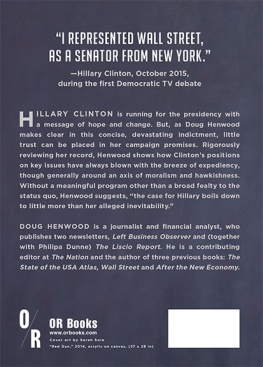They were careless people, Tom and Daisythey smashed up things and creatures and then retreated back into... whatever it was that kept them together, and let other people clean up the mess they had made.
F. Scott Fitzgerald
Hillary Rodham Clinton was all smiles as she stood on a Pentagon stage in early 2013. Buoyant, almost girlish, she was rocking a shapeless deep red blazer with a Peter Pan collar and four large black buttons, as she prepared to take part in another moment of Clinton mythmaking. It was the kind of exquisite brand reinvention and choreographed stagecraft that had been a Clinton hallmark since their first campaign for national office in 1992.
Beside her was the colorless General Martin Dempsey, chairman of the Joint Chiefs of Staff, and Leon Panetta, Barack Obamas jovial secretary of defense. He had served as White House chief of staff for Hillarys husband in his first term as president and remained fiercely loyal to the family through the hard-fought 2008 Democratic primary campaign against Obama. Dressed in a dark suit with a blue-gray tie, Panetta had extolled the former first lady in ways that might make even the most studied Clintonite blush. The burly and gregarious Italian American gushed that Hillary was one of the most informed, most passionate, and most dedicated public servants that Ive had the privilege to serve alongside. He was, just as one would expect, a close ally of Clintons all throughout their time serving at President Obamas request.
Panetta bestowed upon her the Distinguished Civilian Service Award, the Pentagons highest honor, and then dropped a little news to the reporters gathered. In many ways, I have to tell you, it was her inspiration that encouraged me to move forward to be able to bring down the last barriers for women in the Department of Defense and to give them the ability to have a chance to engage in combat. He turned to a beaming Hillary. I thank you for that inspiration.
And so Leon Panetta added another talking point for the Hillary Clinton brand, Version 10 or 12 or 15 by now. The news nugget about Hillarys then-undisclosed role in allowing women to take on combat roles made headlines in U.S. newspapers and around the world. This time, as she gears up for the 2016 election, the outgoing secretary of state sought to be known as the inspirational crusader for the rights of women. Indeed, ever since leaving the State Department, she has urged a review of womens rights around the world, even partnering with her new best buddy, former first lady Laura Bush. That she paved the way for American women finally to serve in combat was just another sign of the impact she had had. Except for the fact that it wasnt technically true.
Contrary to Secretary Panettas assertion onstage that February, national security policy in the Obama administration was not managed by the Department of Defense, or the State Department, for that mattera source of enormous frustration for Secretary Clinton, as well as Panetta and his predecessor as defense secretary, Robert Gates, who in his 2013 memoir noted that Obamas White House was by far the most centralized and controlling in national security of any I had seen since Richard Nixon and Henry Kissinger ruled the roost. Instead, as Gates and other sources within the State and Defense departments have noted, all major policy matters were debated and decided among a small group of Obama loyalists at the White Housewho lacked much, if any, substantive national security experience and operated almost totally through a political lens. Their decisions often were presented to cabinet secretaries as close to a fait accompli.
Also contrary to Panettas boastful assertion, the controversial decision to place women into combat roles was not made as some homage to Hillary Clinton. Indeed, it really had nothing to do with Mrs. Clinton or Mr. Panetta, for that matterboth of whom Obama loyalists viewed with suspicion or disdain. One Obama appointee in the Defense Department, for example, denigrated Panetta as someone more interested in returning home to California every weekend than in running the massive Pentagon bureaucracy.
In 2013 the primary focus of the Obama National Security Council was political, national security sources have told me: reclaiming the House of Representatives in the 2014 midterm congressional elections. Losing the House to the Republicans in 2010 was an embarrassment to the Obama team. Obamas women-in-combat initiative was conceived to ensure that social issues remained front and center in the news. Moreover, women on the front lines would create a compelling visual as Obama Democrats continued to defend against the so-called War on Women, a rallying cry in the 2012 election that sent single female voters to the polls in overwhelming numbers for the Democratic Party.
Far more interesting about the Pentagon ceremony that day was not what was said on the platform but the set of questions surrounding it, those that few asked aloud.
The first, of course, was the state of the honorees health. For one of the first times in weeks, Mrs. Clintons lively brown eyes were finally freed from the strange greenish glasses shed donned since her mysterious collapse the previous December. They had been outfitted with Fresnel prisms to help her see straight after what aides claimed was a concussion she suffered during a fall at home. One of the consequences of the strange adulation/suspicion dynamic that existed between the Clintons and the Washington press corps was that a number of reporters didnt believe the concussion story for a minute.
For several weeks that December, the U.S. secretary of state had not been seen in public, a time when her own record and that of the administration she uncomfortably served had come under its sharpest attack, as a result of the deaths of State Department personnel on her watch in Benghazi, Libya. Some on the right openly speculated that Clinton had concocted this sudden malady to avoid testifying before Congress about Benghazi. However, as has often happened in the past, some of Hillarys wild-eyed enemies on the right seized the opportunity to propose a conspiratorial theoryin this case, that she had a drinking problem. The pretext for this canard was an incident in which she was photographed drinking and partying in Colombiaa scene that ABC News said caused a stir. (The New York Post ran the story under the headline SWILLARY.) After she inexplicably tumbled upon boarding her government planea moment repeatedly played on YouTuberight-wing bloggers had a field day. Rumors of her drinking became so pervasive that even President Obama joked about Hillary drunk texting him. Others believed her health scare was more serious than was publicly known, so serious that it could threaten her large ambitions.
Whether by design or incompetence, the Clinton press team did not help douse speculation. First, reporters were told Mrs. Clinton had disappeared from the public scene because she was under the weather, as if she had a mild cold. The latter malady, in fact, is a common definition of a stroke. According to WebMD, those symptoms include sudden dizziness, loss of balance or loss of coordination... trouble with speaking and understanding... paralysis or numbness of the face, arm or leg... blurred or blackened vision in one or both eyes, or you may see double... a sudden, severe headache, which may be accompanied by vomiting, dizziness or altered consciousness. Concealing these symptoms likely would require a patient to be out of public sight for weeks.
She did not have a stroke, an aide pronounced at one point. Which made reporters familiar with the Clintons believe exactly the opposite.











![Daniel D. Gutierrez [Daniel D. Gutierrez] - Machine Learning and Data Science: An Introduction to Statistical Learning Methods with R](/uploads/posts/book/119585/thumbs/daniel-d-gutierrez-daniel-d-gutierrez-machine.jpg)

